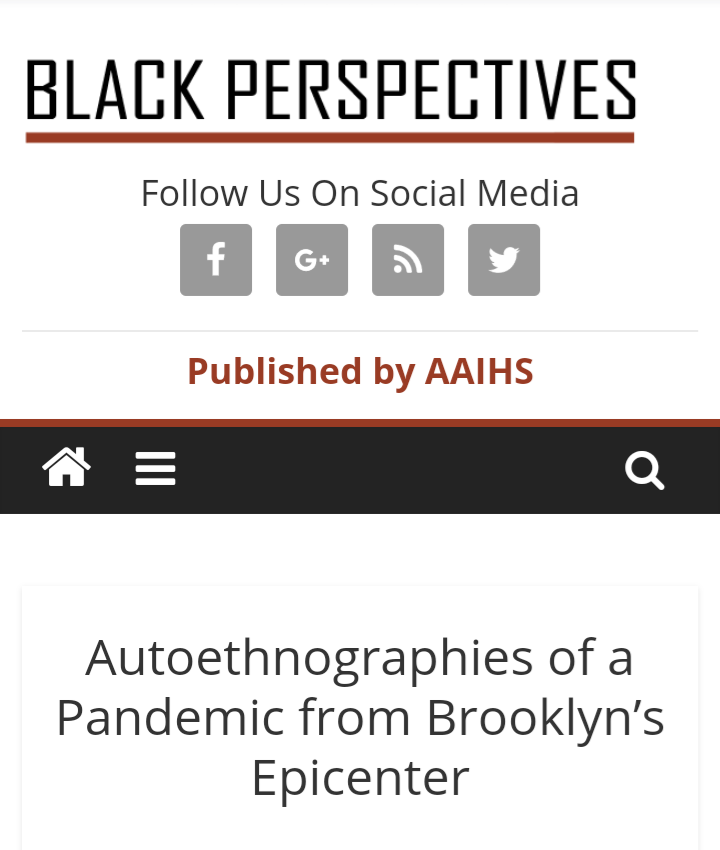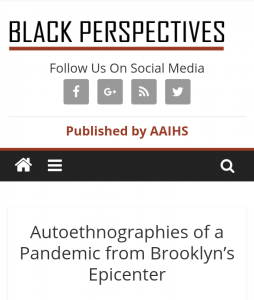
Written By: Stacy Fisch

of a Pandemic from Brooklyn’s Epicenter.”/ AAIHS
The pandemic caught New York City off guard, causing inequalities that already existed locally to worsen. Eight Brooklyn College students shared their perspective living in the city’s hardest-hit communities, documenting their stories in a series called Autoethnographies of a Pandemic from Brooklyn’s Epicenter published by the African American Intellectual History Society (AAIHS).
“Focus on the communities and inequalities that they use to suffer — they did suffer before the pandemic,” said English major and series contributor Areeba Zanub. “It became heightened and became overlooked.”
Before the pandemic, the New York Times conducted a study where they found that the median family income of a BC student is $50,600. English and American Studies professor Joseph Entin, one of the series’s faculty organizers, explained that most students were struggling in different ways because they come from communities that were severely affected, and are essential workers serving on the front lines. “Most BC students come from first-generation college students, immigrants, family of immigrants, and working-class students,” he said.
Most news outlets in the early stages of COVID-19 spoke significantly about essential workers, communities that were struck hard, unemployment, positive cases, and death. Rarely did they touch the surface of anxiety, depression, and other ways the pandemic affected people’s lives.
Political Science professor Jeanne Theoharis, who describes herself as a historian, realized the public sphere was not taking into account the struggles of BC students. Theoharis reached out to the Social Science Research Council (SSRC), an institute that provides funds for the social sciences, and submitted a proposal for an autoethnography student research project. The SSRC approved the proposal this past summer.
“The kind of devastation and all the hard things my students were going through in the spring and not knowing what to do about it,” Theoharis said, “with this, we will mark what happened and we will put our stories forward the way the stories should be.”
Most immigrants and their families come to America working minimum wage essential jobs. Foreign-born and poverty-level families are employed in convenience and grocery stores, or storage facilities. During the pandemic, these essential laborers have fought for hazard pay because they run a high risk of virus contraction. “Many of us came from immigrant families, the people who are being called essential workers, the POC [People Of Color], immigrants, don’t receive health benefits and high wages,” Zanub said. These conditions lead Zanub to believe essential workers aren’t treated fairly. “Especially now, the pressure is on,” she said.
Among the total of 18 essays written about the pandemic, many are filled with true, first hand accounts of how people of color in hard hit communities dealt with the pandemic.
In Jasmine Brathwaite’s essay, A Black Immigrant Experience During the COVID-19 Pandemic, she interviews her father, a 70-year-old essential worker who emigrated from Barbados. Brathwaite speaks about essential workers who were not treated as such before the pandemic. Brathwaite adds links to her piece to support her claim that most essential workers are low-income, and people of color are immigrants. “During the pandemic, half of New York City’s immigrant population became unemployed,” she said in her piece.
Another student, Raul Vaquero, speaks about immigrants as well, although it is slightly different. In Vaquero’s essay, Life Under Trump and COVID-19, he begins his story in the pandemic’s early months. Unfortunately, his parents and relatives contracted the virus, while his uncle was placed under a ventilator, his cousins were alone. Not knowing what to do, the only response is terror if his family will survive.Vaquero’s younger cousins, ten and 7-year- old, were the children of two infected parents. Their father in the ICU, and their mother, as he described as, coughing her lungs out. The 7-year-old worries that while she is alone, ICE will confine her parents while ill.
In 2019 many undocumented immigrants in New York and were arrested by ICE, roughly seventy-five percent of arrests and court meetings were made by ICE in the New York City area and some deported.
Areena Zanub’s essay titled Dealing With Mental Health Stigma During a Global Pandemic describes how taking care of mental health is important now more than ever. At the age of 12, Zanub’s first encounter with mental health came after she collapsed on the floor due to an anxiety attack.
“Already existing racial inequalities, causing an increasing mental health crisis among BIPOC (Black, Indigenous, People Of Color) communities with a reduced access to inclusive therapy and unrelieved mental health stigma,” she wrote in her essay
Recently, however, Zanub received a letter from CUNY about their plans to expand its resources into mental health services and provide funding for counseling. “They are realizing there are more issues that students are facing because of remote learning and issues at home,” she said. When the pandemic hit, mental health became overshadowed by the collapsing healthcare system and rise in unemployment. As a result, most students forgot to take care of their mental well-being, Zanub argues. Many of their concerns centered on financial problems while others concentrated on remote learning. Stories similar to the eight student essays that extended from mental stigma to the experiences of immigrants during COVID-19 that were rarely captured in the media.
Although AAIHS did not publish all 18 of the ethnographies, they were deposited into the Brooklyn Historical Society and Brooklyn College COVID-19 archive. The project anticipated readers to understand the communal hardships many endured during COVID-19, and change society’s view on mental health, health care, and racism. Collectively, these anecdotes demonstrate the day by day challenges and perseverance of BC students. And years from now, they will become part of the city’s history.
